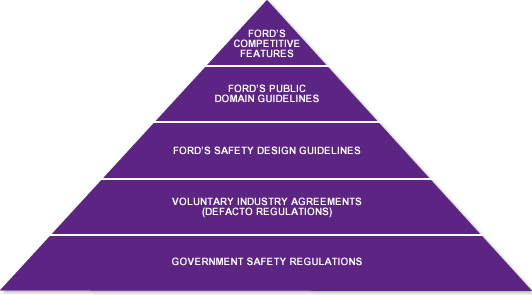How We Manage Vehicle Safety
At Ford, we design and manufacture vehicles that achieve high levels of vehicle safety for a wide range of people over a broad spectrum of real-world conditions. Real-world safety data, driver behavior, research, regulatory requirements and voluntary agreements provide much of the input into our safety processes, including our Safety Design Guidelines (SDGs) and Public Domain Guidelines (PDGs). (See graphic below.) The SDGs are Ford’s stringent internal engineering design targets that exceed regulatory requirements and define additional requirements that are not regulated. The PDGs are Ford guidelines that focus specifically on helping to ensure that our vehicles earn high ratings in relevant public domain assessments (i.e., vehicle safety assessments performed by government or nonprofit entities).
Our PDGs are continually reviewed for possible revisions to address ongoing changes in major public domain vehicle testing programs around the world. Please see the Public Domain Ratings case study for information on these programs.

Internally, Ford utilizes engineering analyses, extensive computer modeling, and crash and sled testing to evaluate the performance of vehicles and individual components. These rigorous evaluations help to confirm that our vehicles meet or exceed regulatory requirements and our own even-more-stringent internal guidelines. Our state-of-the-art crash-test facilities include the Safety Innovation Laboratory in Dearborn, Michigan, and the extensive crash-test facilities in Merkenich, Germany, and Dunton, England. We also operate a high-tech, full-motion driving simulator in Dearborn called VIRTTEX, for VIRtual Test Track EXperiment.
Haddon Safety Matrix
We use the Haddon Safety Matrix to take a holistic view of the factors that may affect vehicle safety. (The matrix was developed by William Haddon, a former administrator of the U.S. National Highway Traffic Safety Administration and also former president of the Insurance Institute for Highway Safety.) The Haddon Matrix illustrates how traffic safety can be the product of complex interactions among the driver, the vehicle and the driving environment.
The Haddon Matrix is used to look at crashes in terms of causal and contributing factors, including human behavior, vehicle safety and the driving environment. Each factor is then considered in the pre-crash, crash and post-crash phases. In the pre-crash phase, the focus is to help avoid the crash. In the crash and post-crash phases, the primary objective is to help reduce the risk of injury to occupants during and after a collision. Another goal is to minimize the amount of time that elapses between the crash and when help arrives.
Human Behavior |
Vehicle Safety |
Environment |
|
|---|---|---|---|
Pre-CrashAccident avoidance |
|
|
|
CrashOccupant protection |
|
|
|
Post-CrashInjury mitigation |
|
|
|
Examples of Ford Actions |
|
|
|










